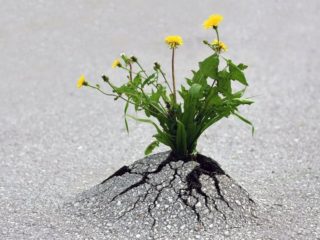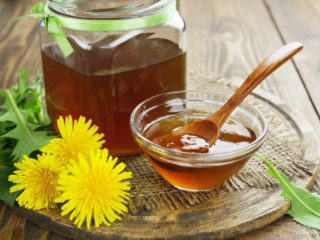Content
Collecting dandelion root for medicinal purposes, as well as leaves and flowers, must take into account the ripening time of the plant. In folk medicine, all parts of the dandelion are used, however, they all have a different peak of usefulness - the time period when they accumulate the maximum possible amount of useful micro- and macroelements. For example, it is better to collect leaves before flowering, before the flowers take over the vital forces of the plant, and the roots - after. Of course, you can ignore these rules; this will not cause any harm to your health. However, the benefits of the raw materials collected for procurement will be much lower than the original ones.
When to collect dandelions for medicine
Regardless of which part of the dandelions is collected for drying or freezing, there are several rules that apply in all cases:
- Collection of raw materials from the same place can be carried out only once every 3 years, not more often. Otherwise, there is a high risk of depleting the flora in the area.
- It is recommended to collect dandelions as far as possible from the roadway. Urban plants, in general, are not suitable for collecting for medicinal purposes - they quickly accumulate toxic substances and are more likely to cause harm to health than benefit. It is best to harvest plants growing in the forest or in a summer cottage.
- There is no need to rush into preparing material for the winter. If you collect dandelions ahead of schedule, the raw materials will be poor in vitamins and nutrients.
When to collect dandelion root for treatment
At dandelion roots, two time periods can be distinguished for collection, when the concentration of nutrients in them is at its peak: spring before flowering (late April - early May) and autumn (September-October). Dandelion root is dried at the same time it is collected.
The collection is carried out as follows:
- All leaves are collected in one bunch.
- Holding them tightly together with the stem, grasping them at the very base, the plant is slowly pulled out of the ground, trying not to break the root. Preliminary watering of the soil will make the process easier - it will be easier to pull the roots out of the softened soil.
- The lateral roots of the medicinal dandelion are cut off.
- After this, the plant is soaked in any suitable container. This is necessary in order to completely soften the remaining clods of earth, so that the roots will be easier to clean later.After 10-15 minutes, the collected material is removed from the water.
Dandelion leaf harvest time
Dandelion leaves are collected and dried in the spring - during this period the concentration of nutrients in them is especially high. Young leaves of those plants that have not yet had time to bloom are most suitable for harvesting - they have not yet transferred their powers to the flowers. They are carefully cut with scissors and placed on a tray or in a basket. It is important to ensure that the leaves do not wrinkle. You should also immediately discard all damaged, yellow and diseased specimens. In addition, the raw materials must be cleaned of insects and unwanted impurities in the form of dry leaves of other plants, etc. Rotted leaves cannot be harvested, so it is better not to delay drying the material.
It is recommended to collect this part of the plant in dry weather or in the afternoon, when the remaining dew has completely dried.
Timing for harvesting medicinal dandelion flowers
The collection of dandelion flowers usually occurs from April to October, and specimens collected from samples collected during active flowering, in May, are especially high-quality.
It is recommended to collect flowers in sunny weather during the day or in the late afternoon. It is advisable that the dew has already left the plants by this time.There should be no visible damage on the flowers in the form of stains, plaque, or debris; specimens with signs of wilting are also not suitable for harvesting. As a rule, only the flower head (or basket) is cut off; the peduncle is usually not touched. It is better not to pick flowers with your hands - there is a high risk of shaking pollen from the petals, which contains a large number of useful macro- and microelements. It is this that determines the main healing qualities of the plant’s flowers. Without it, the heads become practically useless, although some benefit still remains.
Before drying begins, the collected flowers are inspected for foreign debris, insects and other herbs.
How to harvest dandelions for treatment
The biological activity of plants grown on an industrial scale is steadily declining, so people are increasingly collecting herbs on their own, including dandelion: its roots, leaves and flowers. The process of procurement of raw materials occurs in two main directions: the collected material is either dried or frozen. Separately, there is the production of all kinds of decoctions, infusions and jam from dandelions.
How to prepare dandelion roots for medicinal purposes
Harvesting dandelion root begins with cleaning it. The raw materials are thoroughly washed, getting rid of any remaining soil, and dried for some time in the fresh air. After this, the root is put into the freezer with dry freezing. When kept at low temperatures, the collected material retains its beneficial qualities for several years.
An alternative way to harvest plant roots is to dry them.
How to dry dandelion roots
By drying, dandelion roots are harvested in the attic or under a shed - high-quality raw materials can only be obtained if a sufficient amount of oxygen is supplied to it. It is important to place the roots in the shade or partial shade, since when exposed to direct sunlight they lose most of the nutrients.
You can speed up the process by drying it in the oven, however, do not set the temperature too high. The recommended limit is 50°.
Small roots dry out faster than large ones, so quite often the collected raw materials are passed through a meat grinder. Crushed dandelion roots are laid out in a thin layer on a flat surface, having previously spread a cloth or burlap on it. From time to time, the roots are gently mixed.
You can determine the readiness of the dried root by the following signs:
- if the material for harvesting was collected on time and dried according to all the rules, then the roots will be dense and slightly wrinkled;
- when pressed, the root breaks easily and with a bang;
- Dried dandelion root is dark brown on the outside, almost white on the inside;
- the smell is weak or absent at all;
- Properly prepared root tastes slightly bitter.
If, after drying, the roots turn out to be soft and light, it means that poor-quality material was collected or errors were made during the harvesting process. Such raw materials cannot be used for medicinal purposes.
How to prepare dandelion leaves
Dandelion leaves are harvested in the shade, in a well-ventilated, cool room. Recommended temperature is 25-40°.It is important to prevent the leaves from caking - to do this, they are regularly turned over.
How to prepare dandelion flowers
The most important rule for harvesting dandelion flowers is that they should never be washed. Water will inevitably wash away the pollen from the petals, which means that a significant proportion of the beneficial substances will be lost forever.
Flowers collected for drying are transferred to the shade and laid out on a spread cloth in a thin layer. After 10 hours, they are removed to a dry and well-ventilated room with a temperature of 25°. In order to prepare flowers faster, you can put them in the drying chamber and set the temperature to 50°.
Is it possible to freeze dandelion flowers?
Freezing dandelion flowers is very easy. The procedure for freezing raw materials is as follows:
- The collected flowers are slightly dried.
- After this, the green receptacles are removed.
- The yellow petals are placed in a plastic bag and frozen like regular greens.
Storage rules and periods
If all general rules for collecting herbs are followed, dandelion retains its beneficial properties on average from 2 to 5 years. Depending on what part of the plant is being harvested, these parameters may differ slightly.
Dried plant roots last the longest - if you keep them in a cool, dry place, away from sunlight, the shelf life of the raw material will be 4-7 years.The best container option for storing roots, both crushed and whole, is cardboard boxes or wooden boxes.
Dried leaves are stored in a dry place, in bags made of fairly dense material or cardboard boxes. The shelf life of raw materials does not exceed 1-2 years.
Flowers are stored in fabric or paper bags; glass containers are also suitable. In the room where raw materials are stored, it is necessary to maintain room temperature and good air ventilation. Under such conditions, dandelion flowers retain their medicinal properties for 1 year.
Conclusion
It is best to collect dandelion roots for medicinal purposes when they contain the maximum amount of useful substances. The same rule applies to other parts of the plant: leaves and flowers. It is important to remember that in some cases, dandelion-based medications can be harmful to human health, despite the obvious benefits for the body as a whole. This occurs most often with an allergy to the plant, but also infusions, decoctions and other products from dandelions are contraindicated for blockage of the bile ducts, peptic ulcers and gastritis.
You can learn more about the peculiarities of using various parts of dandelion for medicinal purposes from the video below:












